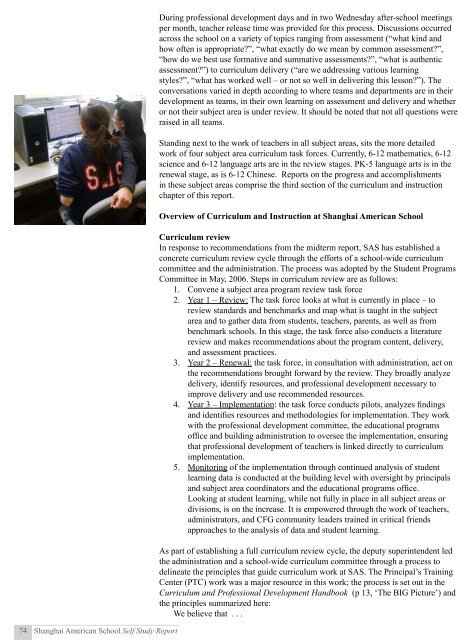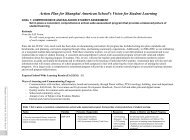Curriculum and Instruction - SAS-WASC
Curriculum and Instruction - SAS-WASC
Curriculum and Instruction - SAS-WASC
You also want an ePaper? Increase the reach of your titles
YUMPU automatically turns print PDFs into web optimized ePapers that Google loves.
During professional development days <strong>and</strong> in two Wednesday after-school meetingsper month, teacher release time was provided for this process. Discussions occurredacross the school on a variety of topics ranging from assessment (“what kind <strong>and</strong>how often is appropriate?”, “what exactly do we mean by common assessment?”,“how do we best use formative <strong>and</strong> summative assessments?”, “what is authenticassessment?”) to curriculum delivery (“are we addressing various learningstyles?”, “what has worked well – or not so well in delivering this lesson?”). Theconversations varied in depth according to where teams <strong>and</strong> departments are in theirdevelopment as teams, in their own learning on assessment <strong>and</strong> delivery <strong>and</strong> whetheror not their subject area is under review. It should be noted that not all questions wereraised in all teams.St<strong>and</strong>ing next to the work of teachers in all subject areas, sits the more detailedwork of four subject area curriculum task forces. Currently, 6-12 mathematics, 6-12science <strong>and</strong> 6-12 language arts are in the review stages. PK-5 language arts is in therenewal stage, as is 6-12 Chinese. Reports on the progress <strong>and</strong> accomplishmentsin these subject areas comprise the third section of the curriculum <strong>and</strong> instructionchapter of this report.Overview of <strong>Curriculum</strong> <strong>and</strong> <strong>Instruction</strong> at Shanghai American School<strong>Curriculum</strong> reviewIn response to recommendations from the midterm report, <strong>SAS</strong> has established aconcrete curriculum review cycle through the efforts of a school-wide curriculumcommittee <strong>and</strong> the administration. The process was adopted by the Student ProgramsCommittee in May, 2006. Steps in curriculum review are as follows:1. Convene a subject area program review task force2. Year 1 – Review: The task force looks at what is currently in place – toreview st<strong>and</strong>ards <strong>and</strong> benchmarks <strong>and</strong> map what is taught in the subjectarea <strong>and</strong> to gather data from students, teachers, parents, as well as frombenchmark schools. In this stage, the task force also conducts a literaturereview <strong>and</strong> makes recommendations about the program content, delivery,<strong>and</strong> assessment practices.3. Year 2 – Renewal: the task force, in consultation with administration, act onthe recommendations brought forward by the review. They broadly analyzedelivery, identify resources, <strong>and</strong> professional development necessary toimprove delivery <strong>and</strong> use recommended resources.4. Year 3 – Implementation: the task force conducts pilots, analyzes findings<strong>and</strong> identifies resources <strong>and</strong> methodologies for implementation. They workwith the professional development committee, the educational programsoffice <strong>and</strong> building administration to oversee the implementation, ensuringthat professional development of teachers is linked directly to curriculumimplementation.5. Monitoring of the implementation through continued analysis of studentlearning data is conducted at the building level with oversight by principals<strong>and</strong> subject area coordinators <strong>and</strong> the educational programs office.Looking at student learning, while not fully in place in all subject areas ordivisions, is on the increase. It is empowered through the work of teachers,administrators, <strong>and</strong> CFG community leaders trained in critical friendsapproaches to the analysis of data <strong>and</strong> student learning.As part of establishing a full curriculum review cycle, the deputy superintendent ledthe administration <strong>and</strong> a school-wide curriculum committee through a process todelineate the principles that guide curriculum work at <strong>SAS</strong>. The Principal’s TrainingCenter (PTC) work was a major resource in this work; the process is set out in the<strong>Curriculum</strong> <strong>and</strong> Professional Development H<strong>and</strong>book (p 13, ‘The BIG Picture’) <strong>and</strong>the principles summarized here:We believe that . . .74Shanghai American School Self Study Report



